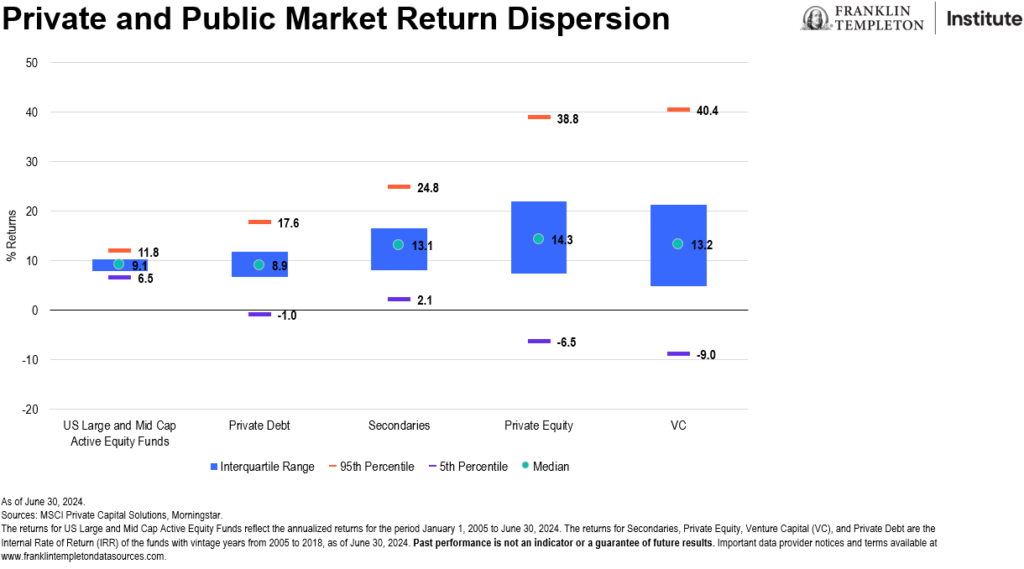In our most recent episode of the Alternative Allocations podcast series, I had the opportunity to sit down and discuss a range of issues with my good friend Scott Welch, from Certuity. Scott brings a unique perspective as a long-time CIO with a deep appreciation for alternative investments. We discussed the role of alternatives in client portfolios, evaluating funds, product evolution, and allocating enough capital to increase the likelihood of achieving goals.
Scott and I discussed the evolution from drawdown structures to evergreen structures, and how they can be used by investors. Scott stated that, “I think that the evergreen facility is a natural fit for private credit. The money gets right to work. There’s no J curve.1 People start generating income right away. It’s a 1099. Right, so there’s a lot of positive aspects to the evergreen structure.”
Given Scott’s experience, I wanted to probe more into evaluating funds and managers. “So, as a point of view, I think you start with the basic four Ps of due diligence—people, philosophy, process, and performance. If you don’t like the people, stop there.” With respect to philosophy, Scott offered some insights regarding what advisors should be evaluating: “Do you believe the approach can work consistently over time?”
If the people, process, and philosophy make sense, then you can evaluate the performance of the manager and similar funds. Scott and I discussed the large dispersion of returns between the top and bottom private markets managers, and emphasized the importance of seeking to allocate capital to the best managers, and avoiding the bottom performers.
Scott noted that, “. . . there is history that shows that the top quartile managers are consistently in the top quartile and those are the folks you need to get access to.” This makes intuitive sense since the top general partners are seeing all the deal flow.
I wanted to know where Scott thought the most attractive opportunities were today. He indicated they have made significant investments in private credit and are feeling more constructive on real estate as valuations have come down. We also discussed one of our highest conviction ideas—secondaries. “The traditional sources of liquidity for the private equity sponsors have not been there as much as they have been in the past. Mergers and acquisitions, strategic sales, and initial public offerings have not been as robust as in the past, and that’s creating, significant discounts and opportunities within the secondaries market.”
Lastly, we closed out the interview by discussing how he allocates to alternative investments. While every client is different, and advisors should evaluate their client’s circumstances, it was instructive to hear Scott describe the way that he thinks about alternatives. He indicated that clients often have a 10% allocation to hedge fund strategies (macro, multi-strategy, etc.); and a 10%-15% allocation to private markets (private equity, private credit, and real estate). Depending upon what they are solving for, clients could have higher or lower allocations to private credit or private equity.
Scott was very generous with his time and his insights. He shared his experience in evaluating funds and allocating capital.
If you missed this, or any of the Alternative Allocation podcasts, don’t forget to subscribe wherever you get your podcast so you don’t miss future episodes, and remember to rate and review to help us improve.
WHAT ARE THE RISKS?
All investments involve risks, including possible loss of principal.
Investments in many alternative investment strategies are complex and speculative, entail significant risk and should not be considered a complete investment program. Depending on the product invested in, an investment in alternative strategies may provide for only limited liquidity and is suitable only for persons who can afford to lose the entire amount of their investment. Diversification does not guarantee a profit or protect against a loss.
Risks of investing in real estate investments include but are not limited to fluctuations in lease occupancy rates and operating expenses, variations in rental schedules, which in turn may be adversely affected by local, state, national or international economic conditions. Such conditions may be impacted by the supply and demand for real estate properties, zoning laws, rent control laws, real property taxes, the availability and costs of financing, and environmental laws. Furthermore, investments in real estate are also impacted by market disruptions caused by regional concerns, political upheaval, sovereign debt crises, and uninsured losses (generally from catastrophic events such as earthquakes, floods and wars). Investments in real estate related securities, such as asset-backed or mortgage-backed securities are subject to prepayment and extension risks
An investment in private securities (such as private equity or private credit) or vehicles which invest in them, should be viewed as illiquid and may require a long-term commitment with no certainty of return. The value of and return on such investments will vary due to, among other things, changes in market rates of interest, general economic conditions, economic conditions in particular industries, the condition of financial markets and the financial condition of the issuers of the investments. There also can be no assurance that companies will list their securities on a securities exchange, as such, the lack of an established, liquid secondary market for some investments may have an adverse effect on the market value of those investments and on an investor’s ability to dispose of them at a favorable time or price. Past performance does not guarantee future results.
IMPORTANT LEGAL INFORMATION
This material is intended to be of general interest only and should not be construed as individual investment advice or a recommendation or solicitation to buy, sell or hold any security or to adopt any investment strategy. It does not constitute legal or tax advice. This material may not be reproduced, distributed or published without prior written permission from Franklin Templeton.
The views expressed are those of the investment manager and the comments, opinions and analyses are rendered as at publication date and may change without notice. The underlying assumptions and these views are subject to change based on market and other conditions and may differ from other portfolio managers or of the firm as a whole. The information provided in this material is not intended as a complete analysis of every material fact regarding any country, region or market. There is no assurance that any prediction, projection or forecast on the economy, stock market, bond market or the economic trends of the markets will be realized. The value of investments and the income from them can go down as well as up and you may not get back the full amount that you invested. Past performance is not necessarily indicative nor a guarantee of future performance. All investments involve risks, including possible loss of principal.
Any research and analysis contained in this material has been procured by Franklin Templeton for its own purposes and may be acted upon in that connection and, as such, is provided to you incidentally. Data from third party sources may have been used in the preparation of this material and Franklin Templeton (“FT”) has not independently verified, validated or audited such data. Although information has been obtained from sources that Franklin Templeton believes to be reliable, no guarantee can be given as to its accuracy and such information may be incomplete or condensed and may be subject to change at any time without notice. The mention of any individual securities should neither constitute nor be construed as a recommendation to purchase, hold or sell any securities, and the information provided regarding such individual securities (if any) is not a sufficient basis upon which to make an investment decision. FT accepts no liability whatsoever for any loss arising from use of this information and reliance upon the comments, opinions and analyses in the material is at the sole discretion of the user.
Products, services and information may not be available in all jurisdictions and are offered outside the U.S. by other FT affiliates and/or their distributors as local laws and regulation permits. Please consult your own financial professional or Franklin Templeton institutional contact for further information on availability of products and services in your jurisdiction.
Issued in the U.S, by Franklin Templeton, One Franklin Parkway, San Mateo, California 94403-1906, (800) DIAL BEN/342-5236, franklintempleton.com. Investments are not FDIC insured; may lose value; and are not bank guaranteed.
1. The “J-curve” is the term commonly used to describe the trajectory of a private equity fund’s cashflows and returns. An important liquidity implication of the J-curve is the need for investors to manage their own liquidity to ensure they can meet capital calls on the front-end of the J-curve.


